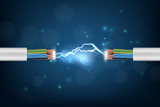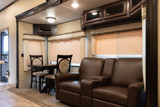Understanding the Basics of Power Converters and Inverters
Managing the power supply in your RV is one of the primary responsibilities of an RV owner in order to keep their motorhome’s electrical systems fully functioning. RVs are designed to utilize AC and DC power for various purposes, including off-grid living. Check out our previous RV Electrical Systems Basics article for more information on this subject.
RV batteries utilize DC power, while the majority of home appliances require AC power. The main differences between AC and DC power are the voltage levels and the direction in which the current flows. DC, or direct current, flows in one direction from negative to positive and produces a low voltage output of 12V. AC, or alternating current, constantly switches the direction of flow, resulting in a much higher voltage output of 120V.
Oftentimes, power will need to be switched from one current form to the other, and that is achieved through devices called converters and inverters. These devices can also operate as battery chargers. This article will discuss the purpose of converters, inverters, and chargers and review important product considerations.

Converters
A power converter outputs 12V DC power from a 120V AC power input. When used in an RV, converters transform the current supplied by the shore power connection into a usable form in order to power DC appliances. You may also hear the term rectifier when discussing converters. A rectifier is a more specific term for the type of converter used in RV applications. This differentiation is typically beyond the scope of the necessary information for most RVers.
Most converters found in modern RVs will also work to charge batteries. These may be specified as converter chargers, which implies additional functioning over battery chargers. A battery charger will only charge and cannot simultaneously provide DC power for immediate use.

Inverters
A power inverter works opposite of a converter and transforms 12V DC power into 120V AC power. Inverters are necessary to run AC appliances off of battery power when you are not connected to shore power.
An inverter charger works similarly to a power inverter but has the additional capability of charging your batteries when connected to a 120V AC source. The inverter charger functions separately as either a power inverter or battery charger but cannot do both at the same time.
Product Specifications & Considerations
In order to determine the appropriate converter or inverter device for your RV electrical system, it is important to consider factors such as output rating, available connections, and safety features. Read on for more information regarding each of these topics.
Voltage Input & Output
Since RV batteries utilize 12V power, choosing an inverter or converter compatible with this voltage level is essential. The same is true for 120V AC appliances. Most converters designated for use in an RV will match these voltages, but it is always good to verify. Outside of North America, 240V AC power is standard.
Continuous Output Rating (Wattage)
The continuous output rating must be greater than the anticipated load demand of the appliances you will be powering. Appliances are labeled with their power requirements for use, including running voltage, wattage, and amp draw. A continuous output rating of at least 1.5 times the combined wattage load of your appliances is recommended.
Peak Surge Demand
The peak surge demand represents the maximum power output the device is capable of producing but is only sustainable for a brief moment. Upon startup, certain appliances will need a greater amount of power than is necessary for continuous operation. The device transforming power needs to be able to handle the initial high power surge to avoid damage.
Sine Wave Output

AC power travels in a pure sine wave, switching continuously between positive and negative peaks, whereas DC power travels in a straight line. A pure sine wave periodically oscillates between the positive and negative peaks in a continuous, steady fashion. Inverting DC power to AC power is done by creating sine waves from the straight waveform. This is done by little switches that flip on and off to change the direction of the DC power flowing through the circuit. On the most basic level, these switches can create square waves that switch between positive and negative but do so slowly and abruptly. Square waves are not useful for the majority of applications. The next step up would be modified sine waves which have switches that operate more frequently to provide a closer resemblance to the pure sine wave. For most applications, this is an acceptable form. But for appliances with an internal motor or microprocessor, the modified sine wave can cause damage due to increased power fluctuations. Pure sine wave inverters are safe for all appliances that use AC power since they output the same exact wave format.
Power Outlet Port
It is important to consider the number of outlets you will need for inverters that will be directly connected to AC appliances. Some inverters even have a USB port if that is something you would consider useful. Typically, the number of outlets will increase with the wattage rating. This is because the more appliances you have running correlates with increased wattage demand.
Safety Features
Live electricity poses a safety risk, especially if the product is overloaded or malfunctioning in some way. When choosing electrical appliances and devices, it is always best to consider the safety features. Automatic shut-off in the case of out-of-range voltage and internal temperature regulation provide short-circuit protection and reduces the risk of an electrical fire. LED indicator panels visually indicate where you are in the safe operating range.
Cost
Whenever you are choosing between multiple product options, cost is always a consideration. The most apparent cost difference is between modified sine wave inverters and pure sine wave inverters, as well as maximum wattage levels. Your anticipated use determines the wattage level; therefore, going down in wattage rating to save money is not sensical because it will be unable to function correctly. When it comes to modified sine wave versus pure sine wave inverters, pure sine wave inverters allow your appliances to run more efficiently and eliminate the risk of damage due to power fluctuations. Modified sine wave inverters are cheaper up front but may cost you power use and potential repairs or replacements in the long run.
Recent Posts
-
Traveling to the RV Hall of Fame in Elkhart, IN
If you are traveling to Elkhart, IN to see the RV Hall of Fame, getting off the toll road at exit 96 …Nov 14, 2025 -
Best RV Air Conditioners of 2025: An Expert Guide From RecPro
Quick Answers Best overall RV air conditioner: RecPro 15K Quiet AC with Heat Pump (RP-AC3800) Best f …Oct 29, 2025 -
The Nuclear Nomads Expand Sofa with New Recliner Section Install
The Nuclear Nomads are a full time RV family living in south Florida. Andi and Joey value quality ti …Oct 24, 2025 -
Trailer Wiring Guide: How to Wire Your Trailer for Safety and Efficiency
Table of Contents 1. Common Types of Trailer Connectors 2. Trailer Wiring Diagrams: Color Codes and …Aug 20, 2024 -
How to Keep Your Pets Safe While Camping
RVing and camping are a great getaway from the hustle and bustle of work and the city and the day-to …Jul 02, 2024 -
Why Replace Your RV Furniture?
You may wonder when is the best time to replace your RV furniture. There is no one right answer to t …May 20, 2024







